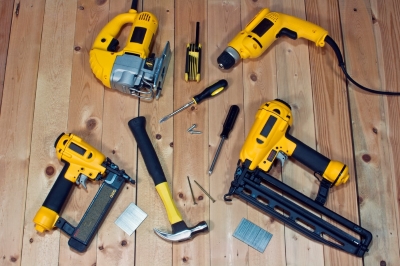Importance Of Construction & Industry Safety Training For Hand and Power Tool Safety
Are your new employees learning to use hand and power tools safely? This is certainly an important topic to cover in a new employee’s construction and/or industry safety training, and is often emphasized during their initial training. Their training doesn’t end at orientation and initial training though. They also learn from the experienced employees that they work with, learning the tricks and techniques of the trade. Logic would suggest that employees who have worked for the company longer are less likely to be injured by hand and power tools because of their experience, and should be good role models and trainers for new hires.
However, injury data from the Bureau of Labor and Statistics, suggests that they aren’t – at least, not as far as hand and power tools go.
Number of nonfatal occupational injuries and illnesses involving days away from work (1) by selected worker and case characteristics and source of injury/illness, All U.S., all ownerships, 2012 – 2015
| Characteristic | TOOLS, INSTRUMENTS, AND EQUIPMENT | |||||
| (code 7XXXXX) | ||||||
| Length of service with employer: | 2012 | 2013 | 2014 | 2015 | Totals | |
| Less than 1 year | 29230 | 27050 | 27410 | 31800 | 115490 | |
| 1 year to 5 years | 29720 | 32370 | 28570 | 31060 | 121720 | |
| More than 5 years | 35530 | 36520 | 32880 | 34150 | 139080 | |
According to data from 2012 to 2015, workers who have been with their companies for 5 or more years are more likely to be injured by their tools than employees with 1 to 5 years of experience, and surprisingly even more likely than new employees with less than 1 year of experience.
This suggests that safe work practices are not related to experience, and that existing safety programs may be assuming that their experienced employees are working more safely than they actually are. When it comes to hand and power tool safety, we need to ensure that we focus on all employees and not just the new hires. It might be that they have comparatively fewer injuries because their safety training is more recent, and they are more likely to be observed and corrected.
Having A Safety Management Plan For Hand & Power Tools
Tool hazards are numerous and can vary depending on the tool and the task, and can include exposure to falling or abrasive objects; splashing substances; harmful dusts, fumes, mists, vapors, or gases; cuts and punctures; and even electrical hazards, to name a few.
When evaluating the hazards of a tool, we need to make sure that we look at the big picture and not just at the tool itself. Thankfully, these hazards can be minimized or even prevented with an effective safety management system that includes thorough job hazard analyses, planning, construction and industry safety training, PPE, re-training, and your commitment to protecting your employees.
That commitment requires that you go beyond just training your employees when they are first hired – it requires that you ensure that your employees continue to use safe work practices after they have been trained. It requires that you provide refreshers and re-training when needed by your employees, not just when mandated by OSHA. It requires that you commit the resources to repairing and replacing tools as they become damaged. It requires that you provide your employees with the right tools for the tasks that you require them to do.
Failure to maintain this commitment will inevitably lead to your employees becoming injured – it is only a matter of time. And as we saw from the injury data, experience alone is not enough to keep your employees safe; if it were, these numbers would be quite different.
 Address & Correct Misuse With Experienced Employees
Address & Correct Misuse With Experienced Employees
Consider the impact that your commitment to your employees’ safety could have on these injury statistics. While it is easy to attribute these injuries to misuse and dismiss the incident as being the employee’s fault, keep in mind that employees do what we give them permission to do. Sure, we may have initially trained them to use tools the proper way, but that training may have been a long time ago, especially considering our employees who have been with us for more than 5 years. In that time, their supervisors, foremen, even management have observed them working, and have likely seen them use the tools incorrectly.
If that misuse is not addressed and corrected with the employees, then we have given them permission to use the tools incorrectly. If this is the case, then both the employee and the company share responsibility for any injuries that employees sustain while misusing tools. Your company’s commitment needs to be more than just words on paper – it must include the commitment from all of your management and supervisory personnel to act and correct unsafe issues.
Maintaining & Replacing Tools
Part of that willingness to act must also include a commitment to maintain, repair, and replace the tools that your employees use. Yes, some of those tools come with a hefty price tag, but when weighted against the cost to our employees for any injuries that they sustain while working for us, that price tag doesn’t look nearly as high. And if the accounting department is concerned about the costs, then it’s time to review the costs of a Worker’s Compensation claim, or the increased cost of insurance as your company’s experience modification rate increases. When compared to those costs, repairing and replacing tools becomes a downright bargain.
We require our employees to work with tools and machinery; therefore, we must ensure that they are protected from any associated hazards. That goes for every employee – from the new hire to the seasoned veteran. Let’s make the commitment to protecting all of our employees, and preventing injuries from happening.


 Address & Correct Misuse With Experienced Employees
Address & Correct Misuse With Experienced Employees





